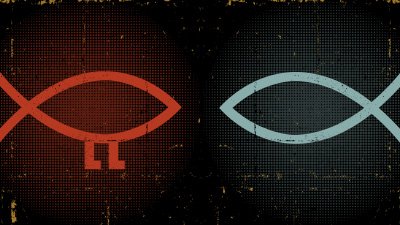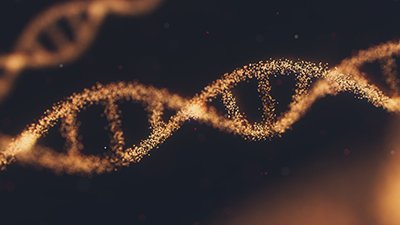Feedback: Observed Evolution
A recent tweet directed at Ken Ham made a frequent evolutionary assertion: “Evolution has been directly observed both in the lab and in the field. If you had done any research whatsoever, you would know this.” The commenter then linked to a couple of studies,1,2 which he claimed proved his point. Unfortunately, he and other evolutionists make some serious errors in interpreting the evidence they observe due to the influence of their worldview and thus undermine their conclusions.
Evolutionists like to point to variation within kinds and claim that species are evolving.
Evolutionists like to point to variation within kinds and claim that species are evolving. While they are not evolving in the sense that affirms Darwinism, species do change as part of a process called speciation. Speciation occurs based on natural variation existing in an organism’s genome. Every species of animal has genetic variability built into its DNA. That allows the population to change in response to environmental conditions for survival. Evolutionists will cite this as evidence for their worldview. However, this change does not support evolution for several reasons.
Populations of organisms change in response to a number of factors, the most obvious being a change in habitat. This is what Charles Darwin and others observed in the finches of the Galapagos Islands. The birds’ beaks varied in structure and thickness depending on the conditions in which the they lived. However, this outward change was rooted in the birds’ genetics. While much of a finch population had what is considered the optimal beak for its conditions, a small portion of the population had a less than optimal beak, but not disadvantageous enough to cull them from the population. This factor kept the information for this beak in the population. When conditions changed again, the less-than-optimal beak became more optimal, and offspring with this beak began to survive more frequently. Conversely, the birds with the beak that had previously been optimal began to struggle to survive, and many died.3 This is illustrative of natural selection, but not evolution.
Natural Selection
Natural selection selects existing information in the genome. It does not produce any new information.
Evolutionists often conflate natural selection with evolution, but they don’t have a scientific basis to do so. Natural selection selects existing information in the genome. It does not produce any new information. New information in the genome would be required to take an existing organism and turn it into a different organism. The finches on the Galapagos Islands have not evolved into mammals or even something between mammals and birds. No matter their beak size, they remain birds, and, more specifically, finches. There is simply a variation in the appearance and function of the bird’s beak. However, because evolutionists have an entirely naturalistic worldview, they interpret this variation as evidence for their theory.
The evolutionists’ insistence on variation being the same thing as evolution is not confined to birds or vertebrates. They have conducted long-running experiments with bacteria, some reaching thousands of generations of bacteria.4,5 These studies have indicated that bacteria change quickly and become genetically unique from one another, rapidly producing primarily different strains. However, the bacteria remained bacteria through thousands of generations. They did not evolve into multicellular organisms. In fact, they did not even change to a new kind of bacteria. This shows that even speciation is not the same as evolution, and variation in the gene pool is not evidence of evolution.
Polyploid Organisms
Evolutionists also periodically cite polyploidy, particularly in plants, as evidence for their worldview. Polyploid organisms have more than two copies of their chromosomes. In some animals, polyploidy is a deleterious mutation with significant consequences to the health and well-being of an organism, sometimes including death. In other animals, it appears to be normal.
However, in many plants, polyploidy is common and contributes to speciation.6 Polyploid species survive and compete well against their diploid cousins. Polyploidy can arise in multiple ways through the plant’s reproductive cycle. Alternatively, it could have been created in some of the original plant kinds. The benefits or detriments of polyploidy are highly debated within the scientific community. Some postulate benefit7; others point to potential negatives.8 Regardless of benefit, this is not evolution in action. The plants remain plants. Speciation is not the same as molecules-to-man evolution. While they do have an extra copy of their chromosomes, they do not have any new information. Polyploidy is somewhat akin to stacking three Bibles atop one another. Only one Bible is needed to know what is in the other two. In the same manner, an extra set of chromosomes is simply an extra copy of the same information. The extra chromosomes have the same information as the preexisting chromosomes. The only difference is in chromosome number. The information on the chromosomes themselves has not changed.
Nothing New
The key takeaway from all of this is that there is no known mechanism that adds useful information to the genome to produce transformation from one kind of organism to another.
The key takeaway from all of this is that there is no known mechanism that adds useful information to the genome to produce transformation from one kind of organism to another. Mutations do not serve this purpose because they merely confuse and jumble existing information. Think of it as a novel. If a person were to remove part of a key sentence from one page of the book and insert it a few hundred sentences away, what would happen? The area it was removed from and the area it was inserted into would no longer make sense to the reader. Essentially, that is what mutations do to the genome as they contain not new information but jumbled existing information, useless to its organism.
Since there is no new, useful information, any change in a species must be based on preexisting information. However, since the information is preexisting in the species genome, there are hard-coded limits to how much and how far populations of organisms can change. If the information for this limited variation exists in a population of organisms and no new information is added, then the only variations that will be observed will be the ones already in the genome. This is why creationists follow the Bible and insist that there is a limit to variation, and this concurs with the observed evidence. Variation happens—no serious scientist dismisses that. However, there are limits to how far that variation will go. The limits are the boundaries of the biblical kinds.
Even some evolutionists will admit to these limitations, including Stephen Jay Gould, perhaps one of the most preeminent evolutionists of the twentieth century. When speaking of marine invertebrates, for example, Gould recognized there was no new information being added.
“We can tell tales of improvement for some groups, but in honest moments we must admit that the history of complex life is more a story of multifarious variation about a set of basic designs than a saga of accumulating excellence.”9
While Gould does not use creationist terminology, he is saying that marine invertebrates vary within certain “basic designs,” which creationists view as the biblical kinds. He even points out that the organisms he is referencing are not “ascending” the evolutionary tree of life or improving in any way. This is despite his evolutionary worldview! Of course, Gould was completely unwilling to change his worldview, despite the evidence, and instead crafted an entirely new evolutionary model to prop up his religion.
Worldview Is Everything
Ultimately how a person views the evidence is dependent upon their worldview. Evolutionists view the world through a secular materialistic worldview and thus interpret everything through that lens. Dr. Richard Lewontin, in a review of another scientist’s book, has voiced what many evolutionists will not.
It is not that the methods and institutions of science somehow compel us to accept a material explanation of the phenomenal world, but, on the contrary, that we are forced by our a priori adherence to material causes to create an apparatus of investigation and a set of concepts that produce material explanations, no matter how counter-intuitive, no matter how mystifying to the uninitiated. Moreover, that materialism is absolute, for we cannot allow a Divine Foot in the door.10
Lewontin is simply pointing out that evolutionists do not observe the evidence impartially. Rather they interpret the evidence based on their commitment to their own biased theory.
The battle is not over the evidence; the battle is over the worldview used to interpret the evidence.
Since creationists accept the biblical account of the origin of life, they interpret the evidence differently. The observable variation in the natural world is a result of the variation built into the original created kinds, as it is stated in the Bible. As Answers in Genesis founder Ken Ham is fond of pointing out, what a person believes is a result of their worldview: “The battle is one between God’s Word and man’s word.”11 Evolutionists choose to base their worldview on man’s fallible word, while creationists base their worldview on God’s infallible Word, the Bible. The battle is not over the evidence: the battle is over the worldview used to interpret the evidence. Evolutionists should heed the comment of Richard Dawkins who said, “Evolution has been observed. It’s just that it hasn’t been observed while it’s happening.12 ”Evolution has not been observed: it has been inferred based on a scientist’s interpretation of evidence in the present, which is essentially what Dawkins is saying.
Footnotes
- K. Yoong Lim, Douglas E. Soltis, Pamela S. Soltis, Jennifer Tate, Roman Matyasek, Hana Srubarova, Ales Kovarik, J. Chris Pires, Zhiyong Xiong and Andrew Leitch, “Rapid Chromosome Evolution in Recently Formed Polyploids in Tragopogon (Asteraceae),” PLOS One (2008). https://doi.org/10.1371/journal.pone.0003353.
- Richard E. Lenski, Dimitri Papdopoulos, Dominique Schneider, Jessica Meier-Eiss, Werner Arber, and Michel Blot, “Genomic evolution during a 10,000-generation experiment with bacteria,” PNAS 96, no. 7 (1999): 3807-3812. https://www.pnas.org/content/96/7/3807.short.
- Georgia Purdom, ““Evolution” of Finch Beaks—Again,” Answers in Depth 1 (2006).
- Richard E. Lenski, Zachary D. Blount and Christina Z. Borland. “Historical contingency and evolution of a key innovation in an experimental population of Escherichia coli.” Proceedings of the National Academy of Sciences 105, no. 23 (2008): 7899–7906. https://www.pnas.org/content/105/23/7899.
- Richard E. Lenski, et al., 1999.
- K. Yoong Lim et al, 2008.
- Thomas G. Ranney, “Polyploidy: From Evolution to New Plant Development,” Combined Proceeding of the International Plant Propagators’ Society 56 (2006): 137–142. https://www.researchgate.net/publication/228633988.
- Sarah P. Otto, “The Evolutionary Consequences of Polyploidy,” Cell 131, 2 (2007): 452–462. https://www.sciencedirect.com/science/article/pii/S0092867407013402.
- Stephen J. Gould, The Flamingo’s Smile: Reflections in Natural History (New York: W.M. Norton, 1985), 240–241.
- Richard Lewontin, “Billions and Billions of Demons” drjbloom.com, January 9, 1997, http://www.drjbloom.com/Public%20files/Lewontin_Review.htm.
- Ken Ham, “The Battle Between God’s Word and Man’s Word,” Answers in Genesis, December 28, 2013, https://answersingenesis.org/blogs/ken-ham/2013/12/28/the-battle-between-gods-word-and-mans-word-continues/.
- Richard Dawkins, “‘Battle over evolution’ Bill Moyers interviews Richard Dawkins,” Now aired December 3, 2004. PBS.

Answers in Genesis is an apologetics ministry, dedicated to helping Christians defend their faith and proclaim the good news of Jesus Christ.
- Customer Service 800.778.3390
- Available Monday–Friday | 9 AM–5 PM ET
- © 2025 Answers in Genesis




